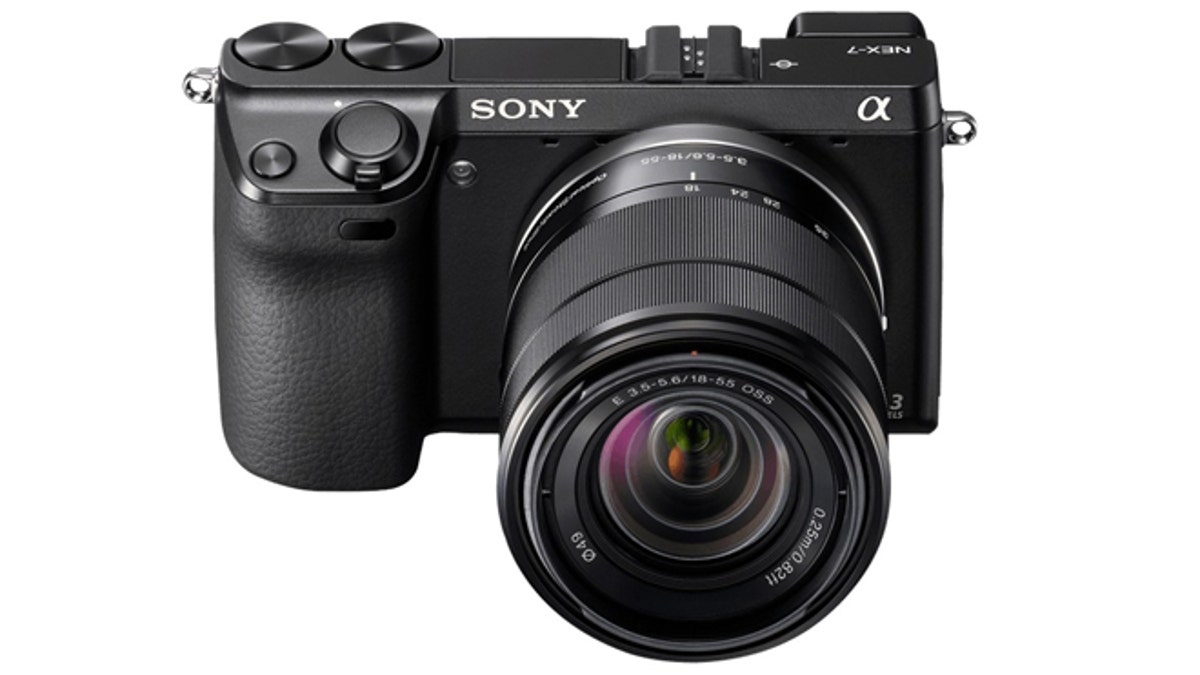
Sony's NEX 7 digital camera. (Sony)
It's the hottest selling camera now. Hybrid cameras, also called mirrorless or compact-system cameras, are compact like a point-and-shoot camera but offer a larger image sensor for better-quality shots. Plus, like more expensive DSLRs, you can change lenses to fit the scene you're shooting.
It's no wonder hybrids are a favorite of hobbyists and professionals alike. Before you head to the store, here are five things you need to know about buying the perfect hybrid camera.
1. Know your image sensors
The image sensor is what captures the light from the object you're shooting. The two main sensor sizes for hybrids are Micro Four Thirds and APS-C.
The smaller Micro Four Thirds sensor is great for portability, but can sacrifice some picture quality. The larger APS-C sensor will add bulk, but can provide better image quality and low-light shooting.
Along with size, you have to consider megapixels, or the number of pixels the sensor can capture. Hybrids typically have 14MP to 24MP. For standard-size photo printing, any amount will work. If you're printing large posters or doing detailed photo editing, more megapixels is better.
If you need a big sensor and lots of megapixels, consider Sony's NEX 7 ($1,099 with 18-55mm lens) with its 24.3MP, APS-C sensor. For a Micro Four Thirds camera, the Panasonic Lumix and Olympus PEN lines are popular options.
Click here to avoid the one mistake every new camera owner makes.
2. Lenses, lenses, lenses
One of the big selling points of hybrids is interchangeable lenses. You can get lenses for close, wide-angle, distance and other types of shots. Make sure you know what lenses are compatible with your camera before you buy.
Micro Four Thirds cameras generally have the widest range of options. You'll find everything from high-end Leica DG lenses to inexpensive "toy camera" Holga lenses.
3. Manual controls
Both professional and hobbyist photographers know the power of manual camera settings. You can tweak your camera for exposure, depth of field, shutter speed and much more to get the perfect shot.
If you need fast setting changes, you want a camera that makes it easy. The Samsung NX20 ($1,099.99 with 18-55mm lens), for example, lets you scroll through settings using the lens' manual focus ring. And the shutter button on the Panasonic Lumix GF6 ($598 with 14-42mm lens) has a quick-access lever that controls aperture and zoom.
However, other cameras might bury important settings away where they're harder to access.
4. The viewfinder
Hybrids use electronic viewfinders to show you what you're shooting. Most hybrids use LCD screens, but OLED screens, which are thinner and brighter outdoors, are also available.
Sony's NEX 7, for example, has two viewfinders. One is a 3-inch, tiltable LCD screen. The other is a small eye-level OLED viewfinder, which gives you the feeling of shooting through a DSLR.
The Panasonic Lumix GF6 has a 3-inch, LCD touch screen that lets you focus and take pictures with a tap on the viewfinder. It also tilts 180 degrees, so you can flip it around for easy self-portraits.
5. Price
With a wide range of price points and features, finding your perfect hybrid camera takes some work.
Click here to learn about buying the right high-quality memory cards for your new camera.
If you're just getting into photography, a lower-priced model like the Sony NEX-3N ($449 with 16-50mm lens) is a solid option. It has a 16.1MP sensor, built-in flash and comes with a collapsible power zoom kit lens.
The Nikon AW1 ($799 with 11-27.5mm lens) is a good mid-range option. It has a 14.2MP sensor, built-in Wi-Fi and GPS. For outdoor shooting, the AW1 is waterproof, freezeproof and shockproof.
Then there are high-end models like Olympus' E-M1 ($1,399.99, body only). It has a splash-proof and dust-resistant body, a fast shutter speed for action shots, Wi-Fi and a tilting touch-screen LCD viewfinder.
In the end, buying a camera is a very personal choice. I strongly recommend visiting a store and playing around with a number of models to find the best fit for you.
Now that you know all about the latest hybrid cameras, get the most out of your new camera with my Essential Guide to Digital Photography.
Copyright 2013, WestStar Multimedia Entertainment. All rights reserved.
Kim Komando hosts the nation's largest talk radio show about consumer electronics, computers and the Internet. To get the podcast, watch the show or find the station nearest you, visit: http://www.komando.com/listen. To subscribe to Kim's free email newsletters, sign-up at: http://www.komando.com/newsletters.




















